最新中考语法专题目的和结果状语从句(讲解练习)
- 格式:doc
- 大小:37.00 KB
- 文档页数:2
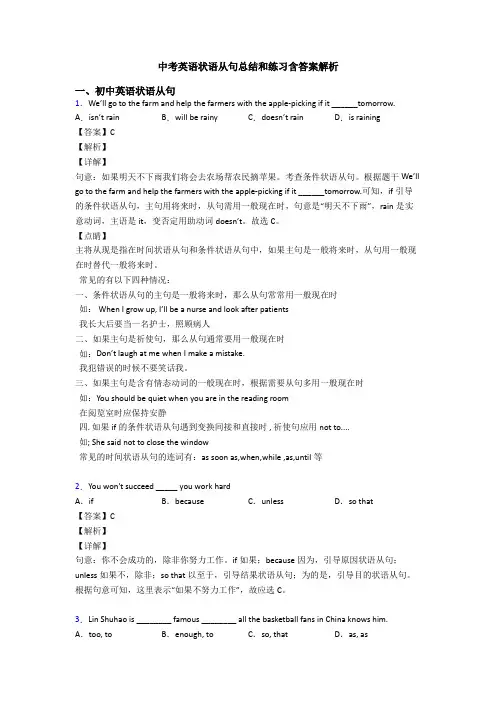
中考英语状语从句总结和练习含答案解析一、初中英语状语从句1.We’ll go to the farm and help the farmers with the apple-picking if it ______tomorrow. A.isn’t rain B.will be rainy C.doesn’t rain D.is raining【答案】C【解析】【详解】句意:如果明天不下雨我们将会去农场帮农民摘苹果。
考查条件状语从句。
根据题干We’ll go to the farm and help the farmers with the apple-picking if it ______tomorrow.可知,if引导的条件状语从句,主句用将来时,从句需用一般现在时,句意是“明天不下雨”,rain是实意动词,主语是it,变否定用助动词doesn’t。
故选C。
【点睛】主将从现是指在时间状语从句和条件状语从句中,如果主句是一般将来时,从句用一般现在时替代一般将来时。
常见的有以下四种情况:一、条件状语从句的主句是一般将来时,那么从句常常用一般现在时如: When I grow up, I’ll be a nurse and look after patients我长大后要当一名护士,照顾病人二、如果主句是祈使句,那么从句通常要用一般现在时如:Don’t laugh at me when I make a mistake.我犯错误的时候不要笑话我。
三、如果主句是含有情态动词的一般现在时,根据需要从句多用一般现在时如:You should be quiet when you are in the reading room在阅览室时应保持安静四. 如果if的条件状语从句遇到变换间接和直接时 , 祈使句应用not to....如; She said not to close the window常见的时间状语从句的连词有:as soon as,when,while ,as,until等2.You won't succeed _____ you work hardA.if B.because C.unless D.so that【答案】C【解析】【详解】句意:你不会成功的,除非你努力工作。
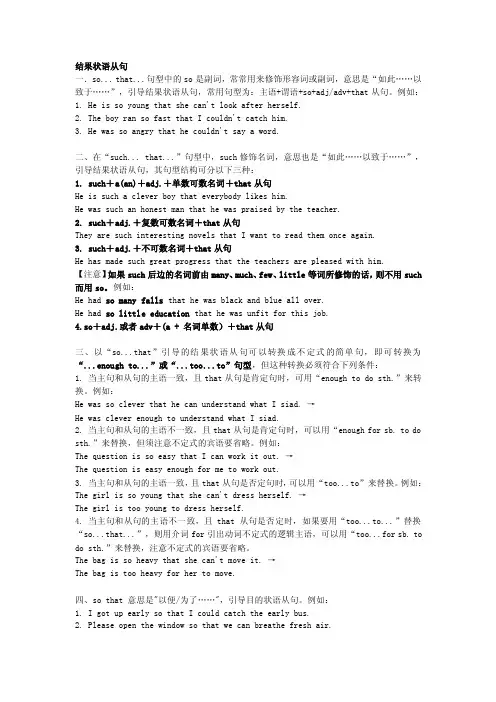
结果状语从句一.so... that...句型中的so是副词,常常用来修饰形容词或副词,意思是“如此……以致于……”,引导结果状语从句,常用句型为:主语+谓语+so+adj/adv+that从句。
例如:1. He is so young that she can't look after herself.2. The boy ran so fast that I couldn't catch him.3. He was so angry that he couldn't say a word.二、在“such... that...”句型中,such修饰名词,意思也是“如此……以致于……”,引导结果状语从句,其句型结构可分以下三种:1. such+a(an)+adj.+单数可数名词+that从句He is such a clever boy that everybody likes him.He was such an honest man that he was praised by the teacher.2. such+adj.+复数可数名词+that从句They are such interesting novels that I want to read them once again.3. such+adj.+不可数名词+that从句He has made such great progress that the teachers are pleased with him.【注意】如果such后边的名词前由many、much、few、little等词所修饰的话,则不用such 而用so。
例如:He had so many falls that he was black and blue all over.He had so little education that he was unfit for this job.4.so+adj.或者adv+(a + 名词单数)+that从句三、以“so...that”引导的结果状语从句可以转换成不定式的简单句,即可转换为“...enough to...”或“...too...to”句型,但这种转换必须符合下列条件:1. 当主句和从句的主语一致,且that从句是肯定句时,可用“enough to do sth.”来转换。
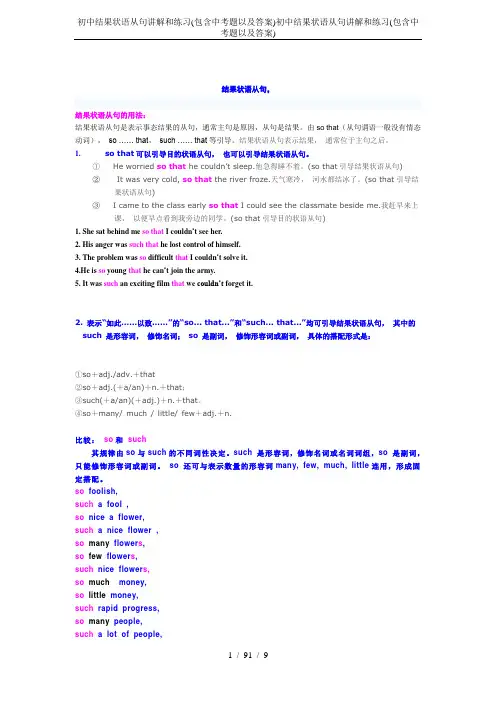
结果状语从句,结果状语从句的用法:结果状语从句是表示事态结果的从句,通常主句是原因,从句是结果。
由so that(从句谓语一般没有情态动词),so …… that,such …… that等引导。
结果状语从句表示结果,通常位于主句之后。
1.so that可以引导目的状语从句,也可以引导结果状语从句。
①He worried so that he couldn’t sleep.他急得睡不着。
(so that引导结果状语从句)②It was very cold, so that the river froze.天气寒冷,河水都结冰了。
(so that引导结果状语从句)③I came to the class early so that I could see the classmate beside me.我赶早来上课,以便早点看到我旁边的同学。
(so that引导目的状语从句)1. She sat behind me so that I couldn’t see her.2. His anger was such that he lost control of himself.3. The problem was so difficult that I couldn’t solve it.4.He is so young that he can’t join the army.5. It was such an exciting film that we couldn’t forget it.2. 表示“如此……以致……”的“so... that...”和“such... that...”均可引导结果状语从句,其中的such 是形容词,修饰名词;so 是副词,修饰形容词或副词,具体的搭配形式是:①so+adj./adv.+that②so+adj.(+a/an)+n.+that;③such(+a/an)(+adj.)+n.+that。
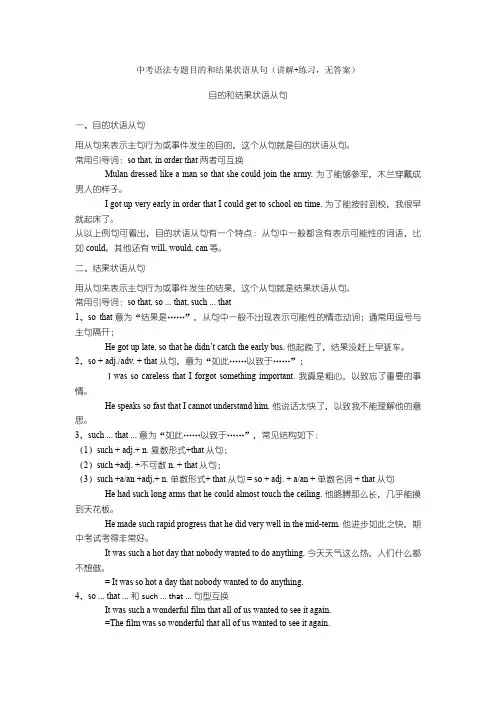
中考语法专题目的和结果状语从句(讲解+练习,无答案)目的和结果状语从句一、目的状语从句用从句来表示主句行为或事件发生的目的,这个从句就是目的状语从句。
常用引导词:so that, in order that 两者可互换Mulan dressed like a man so that she could join the army. 为了能够参军,木兰穿戴成男人的样子。
I got up very early in order that I could get to school on time. 为了能按时到校,我很早就起床了。
从以上例句可看出,目的状语从句有一个特点:从句中一般都含有表示可能性的词语,比如could。
其他还有will, would, can等。
二、结果状语从句用从句来表示主句行为或事件发生的结果,这个从句就是结果状语从句。
常用引导词:so that, so ... that, such ... that1、so that意为“结果是……”,从句中一般不出现表示可能性的情态动词;通常用逗号与主句隔开;He got up late, so that he didn’t catch the early bus. 他起晚了,结果没赶上早班车。
2、so + adj./adv. + that从句,意为“如此……以致于……”;Iwas so careless that I forgot something important. 我真是粗心,以致忘了重要的事情。
He speaks so fast that I cannot understand him. 他说话太快了,以致我不能理解他的意思。
3、such ... that ... 意为“如此……以致于……”,常见结构如下:(1)such + adj.+ n. 复数形式+that从句;(2)such +adj. +不可数n. + that从句;(3)such +a/an +adj.+ n. 单数形式+ that从句 = so + adj. + a/an + 单数名词 + that从句He had such long arms that he could almost touch the ceiling. 他胳膊那么长,几乎能摸到天花板。
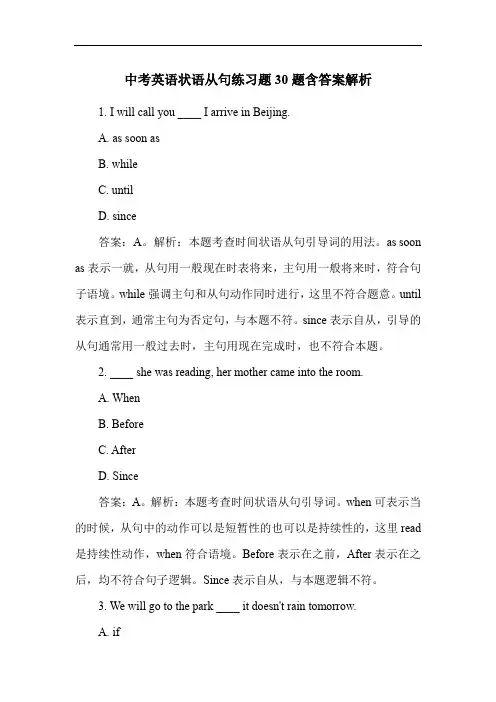
中考英语状语从句练习题30题含答案解析1. I will call you ____ I arrive in Beijing.A. as soon asB. whileC. untilD. since答案:A。
解析:本题考查时间状语从句引导词的用法。
as soon as表示一就,从句用一般现在时表将来,主句用一般将来时,符合句子语境。
while强调主句和从句动作同时进行,这里不符合题意。
until 表示直到,通常主句为否定句,与本题不符。
since表示自从,引导的从句通常用一般过去时,主句用现在完成时,也不符合本题。
2. ____ she was reading, her mother came into the room.A. WhenB. BeforeC. AfterD. Since答案:A。
解析:本题考查时间状语从句引导词。
when可表示当的时候,从句中的动作可以是短暂性的也可以是持续性的,这里read 是持续性动作,when符合语境。
Before表示在之前,After表示在之后,均不符合句子逻辑。
Since表示自从,与本题逻辑不符。
3. We will go to the park ____ it doesn't rain tomorrow.A. ifB. thoughC. becauseD. so答案:A。
解析:本题考查条件状语从句(可视为一种特殊的时间状语从句)。
if表示如果,引导条件状语从句,从句用一般现在时表将来,主句用一般将来时,这里表示如果明天不下雨就去公园。
though 表示虽然,because表示因为,so表示所以,均不符合题意。
4. You can't see the stars clearly ____ there is too much light pollution.A. whereB. whenC. ifD. because答案:D。
解析:本题考查原因状语从句。

初中英语语法专题讲座——状语从句状语从句在复合句中作状语,修饰动词、形容词或副词等。
状语从句可以表示时间、条件、原因、地点、目的、结果、让步、方式、比较等意义。
知识梳理:提纲挈领,抓住重点和难点!各类状语从句连接词(短语)一览表:时间when,while,as,assoon as,since,until,after,before,a slongas(长达……之久)条件 If,unless,as/so long as(只要)原因 As,because, since,as/so long as(既然,因为)地点 Where目的So that(为了),in order that结果 So that(方便), so…that,such…that让步 though, although, evenif,however方式As比较 than,(not)as…as,时间状语从句:Whenever he comes,hebrings a friend。
他每次来都带个朋友。
They allcontinuedtheir regardfor me as long as they lived.他们毕生都在关心着我。
条件状语从句:Aslong as I amalive, I will goon studying.只要我活着,我就要学习。
原因状语从句:Since we live nearthe sea,we enjoy nice weather.由于我们住在海边,能享受到好的天气.地点状语从句:Put it where we can all see it.把它放在我们都能看到的位置。
目的状语从句:Finish this sothat you canstartanother。
把这个做完,(为了)你可以开始另一个。
结果状语从句:Hewas soangry thathe couldn’t say aword。
他气得说不出话了。
让步状语从句:Though heis in poor health,he works hard。

初中英语状语从句讲解、练习与答案状语从句状语从句用来修饰主句中的动词,副词和形容词的从句叫状语从句。
根据其含义状语从句可分为时间状语从句,地点状语从句,条件状语从句,原因状语从句,结果状语从句,比较状语从句,目的状语从句,让步状语从句。
1. 时间状语从句(1)时间状语从句常用when, as, while, before, after, since, till, until, as soon as等连词来引导。
例如: It was raining hard(rain hard 下大雨) when I got to school yesterday. While he was doing his homework, the telephone rang. As he walked along(沿着走) the lake, he sang happily. He had learned a little Chinese before he came to China. After he finished middle school, he went to work in a factory.(2)在时间状语从句里,通常不用将来时态,用现在时态表示将来的动作或状态。
例如:I’ll ring you up as soon as I get to New York.I will tell him everything when he comes back. He won’t believe it until he sees it with his own eyes.(3)在带有till或until引导的时间状语从句的主从复合句里,如果主句用肯定式,其含义是“一直到……时”,谓语动词只能用延续性动词。
如果主句用否定式,其含义是“直到……才……”, “在……以前不……”, 谓语动词可用瞬间动词。
例如:The young man read till the light went out(熄灭).Let’s wait until the rain stops.We won’t start until Bob comes.Don’t get off(从下来) until the bus stops.【Till是指直到某一特定事件发生的时候,而在那个时刻之后,该事情或状况仍将持续。

语法专题十四、状语从句(必考)一个句子做整句话的状语,这个句子就叫做状语从句。
状语从句根据从句在整句中表示的含义不同又可细分为时间状语从句、地点状语从句、原因状语从句、结果状语从句、目的状语从句、条件状语从句、让步状语从句、比较状语从句、方式状语从句等。
接下来我们重点复习几类状语从句。
一、时间状语从句定义和特征英语里如果用从句来表达一件事情或者一个动作发生的时间,那么这个从句就叫时间状语从句。
时间状语从句通常由when, while, as, before, after, since, as soon as, till/until等词引导。
【特征】含有时间状语从句的复合句,如果主句用一般将来时,从句用一般现在时表示将来。
(主将从现)(2021·全国·单元测试)—Daddy, when will we go out to fly a kite?—As soon as the rain _____.A. is stoppingB. stoppedC. will stopD. stops几种常见时间状语从句。
1.when引导:when表示“当……时候”。
既可表示在某一时间点发生的事,又可表示在某一时间段发生的事。
主句与从句描述的动作或事情可以是同时发生,也可以先后发生。
✧When I got home, I found my baby girl singing in the living room.当我到家时,我发现我的小女儿正在客厅里唱歌。
✧Things were different when I was a child.我小时候情况与现在不同。
【注意】when从句中的谓语动词可以是延续性动词,也可以是短暂性动词。
2.while引导:while表示“当……时候;在……期间”。
强调主句和从句的动作在同一时间发生。
考点精讲✧My mom came in while I was watching TV. 我正在看电视的时候,妈妈进来了。

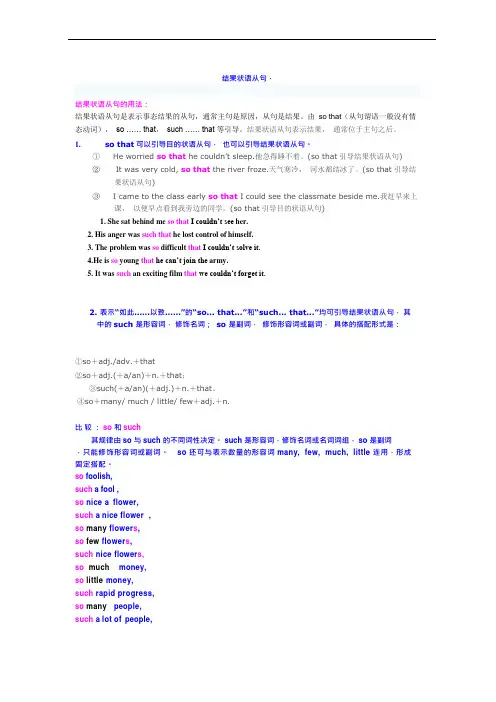
结果状语从句,结果状语从句的用法:结果状语从句是表示事态结果的从句,通常主句是原因,从句是结果。
由so that(从句谓语一般没有情态动词),so …… that,such …… that 等引导。
结果状语从句表示结果,通常位于主句之后。
1.so that 可以引导目的状语从句,也可以引导结果状语从句。
①He worried so that he couldn’t sleep.他急得睡不着。
(so that 引导结果状语从句)②It was very cold, so that the river froze.天气寒冷,河水都结冰了。
(so that 引导结果状语从句)③I came to the class early so that I could see the classmate beside me.我赶早来上课,以便早点看到我旁边的同学。
(so that 引导目的状语从句)1.She sat behind me so that I couldn’t see her.2.His anger was such that he lost control of himself.3.The problem was so difficult that I couldn’t solve it.4.He is so young that he can’t join the army.5. It was such an exciting film that we couldn’t forget it.2. 表示“如此……以致……”的“so... that...”和“such... that...”均可引导结果状语从句,其中的such 是形容词,修饰名词;so 是副词,修饰形容词或副词,具体的搭配形式是:①so+adj./adv.+that②so+adj.(+a/an)+n.+that;③such(+a/an)(+adj.)+n.+that。
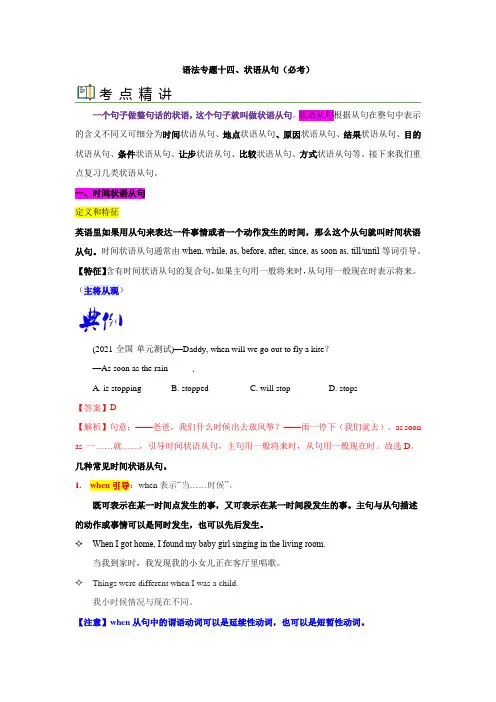
语法专题十四、状语从句(必考)一个句子做整句话的状语,这个句子就叫做状语从句。
状语从句根据从句在整句中表示的含义不同又可细分为时间状语从句、地点状语从句、原因状语从句、结果状语从句、目的状语从句、条件状语从句、让步状语从句、比较状语从句、方式状语从句等。
接下来我们重点复习几类状语从句。
一、时间状语从句定义和特征英语里如果用从句来表达一件事情或者一个动作发生的时间,那么这个从句就叫时间状语从句。
时间状语从句通常由when, while, as, before, after, since, as soon as, till/until等词引导。
【特征】含有时间状语从句的复合句,如果主句用一般将来时,从句用一般现在时表示将来。
(主将从现)(2021·全国·单元测试)—Daddy, when will we go out to fly a kite?—As soon as the rain _____.A. is stoppingB. stoppedC. will stopD. stops【答案】D【解析】句意:——爸爸,我们什么时候出去放风筝?——雨一停下(我们就去)。
as soon as 一……就……,引导时间状语从句,主句用一般将来时,从句用一般现在时。
故选D。
几种常见时间状语从句。
1.when引导:when表示“当……时候”。
既可表示在某一时间点发生的事,又可表示在某一时间段发生的事。
主句与从句描述的动作或事情可以是同时发生,也可以先后发生。
✧When I got home, I found my baby girl singing in the living room.当我到家时,我发现我的小女儿正在客厅里唱歌。
✧Things were different when I was a child.我小时候情况与现在不同。
【注意】when从句中的谓语动词可以是延续性动词,也可以是短暂性动词。
原因目的结果状语从句专练1.原因状语从句:
-因为他生病了,所以他没有去上班。
-因为下雨了,所以我们取消了郊游计划。
-由于机械故障,飞机延误了两个小时。
2.目的状语从句:
-我们买了食材,以便能在家里做饭。
-他努力学习,为的是能够考上理想的大学。
-我们早早出发,以免堵车。
3.结果状语从句:
-她很努力学习,结果考试成绩优秀。
-他交了很多朋友,因此在新城市生活得很开心。
-外面太冷了,因此我们决定在家里看电影。
4.状语从句综合练习:
-因为他没有及时交作业,所以被老师批评了。
-为了提高口语能力,他每天都会和外国人练习对话。
-他看到警察,于是加快了脚步。
-由于下雨了,我们决定取消了户外活动。
-我们买了很多菜,以便做一顿丰盛的晚餐。
-她学习很努力,结果考试得了满分。
-妈妈担心我走夜路不安全,所以每天都来接我放学。
-我们计划早早出发,以免迟到。
专题15 状语从句本章节内容 1. 状语从句的概述2.时间状语从句3.条件状语从句4.原因状语从句5.目的状语从句6.结果状语从句中考对状语从句的考查会和从属连词相结合,主要为在状语从句中考查从属连词的辨析及应用。
常见的有although/though/even though引导的让步状语从句。
if/unless引导的条件状语从句。
until/when/while/as soon as引导的时间状语从句。
because引导的原因状语从句,so that引导的目的状语从句等。
if引导的条件状语从句和when引导的时间状语从句一般都会和时态相结合,即主要考查“主将从现”原则。
对于状语从句的学习可与专题六从属连词相结合。
在时间状语从句和条件状语从句中,主句和从句的时态一致问题一般有两种情况:(1)“主将从现”:主句用一般将来时,而从句用一般现在时。
常见的使用“主将从现”原则的连词有:表示时间的when, while, after, before, until, till, whenever, as soon as, as long as, once 等;表示条件的if, unless, so long as, in case等。
(2)“主祈从现”:若主句是祈使句,或主句中有情态动词时,那么从句用一般现在时表示将来。
(3)“主情从现”:若主句有情态动词, 那么从句用一般现在时表示将来。
如:You can get good grades if you study hard. 如果你努力学习,你将取得好成绩。
一、状语从句的概述状语从句由从属连词引导,与主句连接,位于句首时,常用逗号与主句分开,位于句末时,其前一般不用逗号。
状语从句根据其用途可分为时间状语从句、条件状语从句、原因状语从句、目的状语从句、结果状语从句、让步状语从句、比较状语从句、地点状语从句等。
状语从句的分类从句的引导词例句时间状语从句when/while/as(当……时),before(在……之前),after(在……之后),since(自从……以来),not...until(直到……才),as soonas(一……就……)I was doing my homework when my father camein.当我爸爸进来的时候我正在做作业。
初中英语语法专练—原因、结果和目的状语从句-全考点详解一、状语从句状语从句是指在整句中作状语时,起副词作用的句子。
它可以修饰谓语、非谓语动词、定语、状语或整个句子。
根据其作用可分为时间、地点、原因、条件、目的、结果、让步、方式和比较等从句。
状语从句一般由连词(从属连词)引导,也可以由词组引起。
二、原因状语从句如果从句表示的是主句行为的原因,就构成原因状语从句。
原因状语从句由表示原因的连词引导,常用的有because,since,as等。
1.because引导的原因状语从句,表示的往往是读者不了解的、不明显的原因,是全句叙述的重点,语气最强。
because引导的原因状语从句既可以放在主句之前,用逗号隔开,也可以放在主句之后。
如:He failed the exam because he was too careless.2.since引导的原因状语从句,表示显然的或已为人知的理由,常译为"因为;既然"。
如:Since everyone is here,let's start our meeting.3.as引导的原因状语从句,意为"因为;由于",其语气不如because 强,通常为附加说明的理由,且是已知晓的原因,主句与从句没有逻辑上的因果关系。
如:As she wasn't well, I went there alone.三、结果状语从句如果从句表示的是主句行为的结果,就构成结果状语从句。
结果状语从句由表示结果的连词引导,常用的有so,so...that...,such...that...等。
1.so引导的结果状语从句,表示"由于某个行为而导致的结果",只能放在主句之后。
如:He worked too hard, so he fell ill again.注意:because和so不能同时用在一个句子里。
如:Because it rained heavily, we stayed at home./It rained heavily, so we stayed at home.2.so...that...引导的结果状语从句,意为"太......以致于......",so后面接形容词或副词(看so前面的词来决定用形容词还是副词,如果是系动词就用形容词;如果是行为动词,就用副词。
中考英语-原因、结果、目的状语从句讲解+练习状语从句总结一、原因状语从句(1)原因状语从句通常由because, since, as, for引导。
(2)because表示直接原因,语气最强。
because引导的原因状语从句多放在主句之后。
回答由why提出的问题,只能用because。
此外,because和so不能同用在一个句子里。
例如:------Why aren’t going there?------Because I don’t want to.since引导原因状语从句,相当于now that,意思是“因为……,既然……,鉴于……”。
例如:Since the rain has stopped,let’s go for a walk. 既然雨停了,我们出去散散步吧。
as和since语气较弱,一般用来表示明显的原因。
由as和since引导的原因状语从居多放在句首。
例如:As he has no car, he can’t get there easily.Since we have no money, we can’t buy it.(3)for表示所说的理由是一种补充说明,for引导的从句一般不放在句子的开头。
如:I decided to stop and have lunch, for I was feeling quite hungry.练习:I was late for class yesterday _______ there was something wrong with my bike.He took off his coat _______ he felt hot.you can’t answer the question, I’ll ask someone else.二、结果状语从句(1)结果状语从句由so…that, such…that, so that引导。
(2)so…that语such...that可以互换。
中考英语复习一一状语从句讲解及练习状语(1)说明动作“何时”、“何地”、“如何”发生,或者说明形容词或副词的程度,一般由副词、介词短语、不定式、状语从句等充当。
如:I was not born yesterday.(我又不是昨天才出世的娃娃。
)/ For many of these families a college educationwas something new.(对其中的许多家庭来说,大学教育是件新事物。
)/ He woke up to find his house on fire.(他醒来发现房子着火了。
) / You cannot leave until your work is finished.(在你的工作被完成以前你不能离开)(2)副词作状语位置较为灵活,;介词短语作状语,位置基本固定,;不定式作状语,一股表示目的、结果,;从句作状语(3)多个状语相连时,一般先单词、后短语,先地点、后时间,先小概念、后大概念。
如:He went ouf of the room at a quarter to 23:00 lastnightand then disappeared into the dark.(他昨夜22点3刻从房间里出来,然后消失在黑暗之中。
)/(4)状语还可以用从句来充当,有时间状语从句、地点状语从句、原因状语从句、目的状语从句、结果状语从句、比较状语从句、让步状语从句、条件状语从句等。
详见“状语从句”。
(5)注意:由于状语属于修饰性的成分,常归入谓语,因此不作为句子的主要成分。
1时间状语从句:在一个句子中作时间状语的句子。
时间状语的连接词:when(当•一时候)while(当•一时候)as(当•一时候)after(在•…以后)before(在…以前)as soon a就)since(自从•一至U现在)till/until(直到•…才)by the time(到•…为止)依旧是连接词后加陈述语序。
状语从句状语从句用来修饰主句中的动词,副词和形容词的从句叫状语从句。
根据其含义状语从句可分为时间状语从句,地点状语从句,条件状语从句,原因状语从句,结果状语从句,比较状语从句,目的状语从句,让步状语从句。
1. 时间状语从句(1)时间状语从句常用when, as, while, before, after, since, till, until, as soon as等连词来引导。
例如:It was raining hard(rain hard 下大雨)when got to school yesterday.While he was doing his homework, the telephone rang.As he walked along(沿着走)the lake, he sang happily.He had learned a little Chinese before he came to China.After he finished middle school, he went to work in a factory.(2)在时间状语从句里,通常不用将来时态,用现在时态表示将来的动作或状态。
例如:I’ll ring you up as soon as I get to New York.I will tell him everything when he comes back.He won’t believe it until he sees it with his own eyes.(3)在带有till或until引导的时间状语从句的主从复合句里,如果主句用肯定式,其含义是“一直到……时”,谓语动词只能用延续性动词。
如果主句用否定式,其含义是“直到……才……”, “在……以前不……”, 谓语动词可用瞬间动词。
例如:The young man read till the light went out(熄灭).Let’s wait until the rain stops.We won’t start until Bob comes.Don’t get off(从下来)until the bus stops.【Till是指直到某一特定事件发生的时候,而在那个时刻之后,该事情或状况仍将持续。